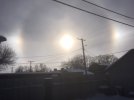XPan
The Living Force
I went for a walk yesterday and wondered about this strange sky beforehand. It was like it was somehow surreal. Everything was yellow/orange. And it was eerily quiet... although cars were driving. I can't really describe it. Unfortunately, I only had my mobile phone with me to take pictures and with all the automatic enhancements that modern mobile phone cameras have, I couldn't capture this image. It was very strange.
Then this morning I found this article on Sott.net and maybe it could have been an offshoot of that. But I don't know. We live in Nuremberg, which is towards the south in Germany. Today the sky seems to be back to normal, but heavy snowfall is predicted by the weather services in our area as well. I am grateful for home office for the next 4 weeks.
Wow @Mililea
You are truly observant. What you likely saw was the dust blowing from the Sahara northwards all the way to Southern Germany ! It was reported in the Alps, due to the strong flow of very mild air over Southern Europe drifting to the north.
Auto White Balance issues
Yeah, and those mobile phones sux, because their automatic white balance always iron out any color shifts. What you could do, is to enable a filter on purpose, so that the final results resemble what you naked eye saw ! That is a workaround to the problems with auto white balance.
Tropical Night in Sicily
In Sicily the stream of warm air created very strong Scirocco wind (kind of like Föhn winds in the Alps can do, which exaggerate high temperatures due to their nature of falling down behind a mountain chain, on the lee side it dries out, and the movement down accelerates the rise of temperature further. Often attached to very high wind speeds)
So, that situation created over the North Coast of Sicily temperatures up to 29°C in Palermo and 28° in other locations along the North Coast - as well a few places recorded tropical nights (MIN temperatures not going below 20°C). Even in Catania on the east coast of Sicily, reported a MAX of 25°C
My husbands ex Wife, Mary, went to the beach of Catania, taking a swim !!!
The photo below, from 6 Feb 2021, I got from a friend who lives in Catania.





 If unknown to the viewer, you are given the impression that "a city reports extreme low temperatures" - but the answer can be a geographical one...
If unknown to the viewer, you are given the impression that "a city reports extreme low temperatures" - but the answer can be a geographical one...